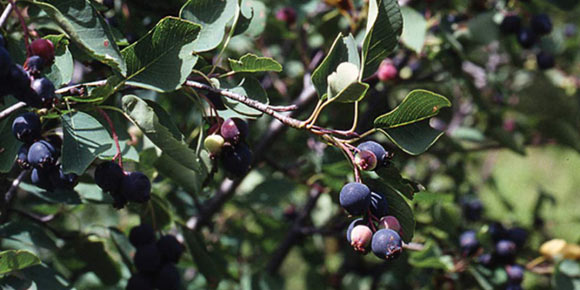Picking saskatoons in early July was a tradition among prairie kids. Off we would go, swinging gallon ice cream or jam pails that would be filled to the brim before we headed home, usually before dusk and early enough to avoid the worst of the mosquitoes.
Today, saskatoon picking is more likely to take place on some civilized farm from neatly planted rows of bushes. The fruit will be bigger and more consistently sweet as the growers tame the wildness out of this true North American fruit, but the almond-tasting seeds will still impart a flavour that can’t be replicated.
Saskatoons, Amelanchier alnifiolia, may look a little like blueberries, but are more closely related to the rose family, as are apples and hawthorn and even mountain ash. Saskatoons are also less fussy about where they grow than are blueberries, happy to be put in somewhat neutral soil with decent drainage. They will even tolerate light shade and still produce.
If you plant saskatoons, expect a shrub that will probably reach 16 feet tall but which will continue to reward you with fruit from their third year and thereafter for up to 70 years, but at least for 30. Most varieties are multi-stemmed bushes, although this varies from small patchy shrubs to the tall serviceberry of the east.
Saskatoons, as we know them, were named by the Cree, who called them misaskwatomina or “fruit of the tree of many branches”. They are also known as prairie berry, serviceberry, shadbush (in the east because the fruit ripened “when the shade fish run”), juneberry and even pigeon berry.
High levels of vitamins
Saskatoons contain very high levels of calcium and iron but also vitamins C, A and E, as well as a host of minerals including manganese, magnesium and copper. They have high levels of anthocyanins, flavonols and phenolics. There are about 85 calories in 100 grams. The calcium levels of saskatoons are higher than in red meat and the berries are filled with three times as much iron and copper than raisins.
The Cree used dried saskatoons to make pemmican. Dried lean meat was pounded to very small pieces, almost powder, and added to an equal amount of melted buffalo or other wild game fat. Dried saskatoon (and sometimes other) berries were also pounded and added. The resulting pemmican would keep for up to 10 years, was light weight for travel, and was high in protein and other nutrients.
Pemmican could be eaten raw or cooked, although the latter was preferred. Pemmican was a critical staple of the prairies and is said to have been the catalyst that created the Riel Rebellion in Manitoba when the Hudson Bay Company Governor of the Red River Colony issued the Pemmican Proclamation that forbade the export of pemmican for the coming year.
This enraged the Metis who worked for the North West Company and needed pemmican to continue their trade. The ban ultimately resulted in what is known now as the Battle of Seven Oaks. During the skirmish, 21 settlers were killed, including the governor.
So goes the importance of a tiny berry to the history of the nation. A few years later, the two fur trading companies were merged and all the killing was for nothing.
Known as Juneberries in the U.S.
Today, the saskatoon berry market is growing. The first ever saskatoon orchard was created just a scant 20 years ago and now saskatoons are the second largest commercial fruit crop on the prairies (strawberries are number one), with demand exceeding production. They are being marketed in the United States as juneberries.
In the home garden, look for the variety called Standing Ovation. It has a columnar growth habit, reaching 12 feet, so it fits well in the city landscape. It is covered in masses of five-petalled, white flowers in springtime followed by clusters of deep purple berries. Leaves emerge red in springtime, becoming green in summer and turning yellow in fall. Its lifespan is about 30 years.
Nelson Saskatoon is a late blooming variety that reaches five feet tall and wide.
Dorothy Dobbie is the owner/publisher of Manitoba Gardener magazine. She broadcasts a weekly gardening show on CJNU 93.7 FM at 8:00 Sunday mornings. Call 204-940-2700 for subscriptions. Localgardener.net



